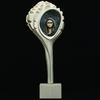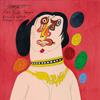
Frank Wimberley
BERRY CAMPBELL PRESENTS A SURVEY OF PAINTINGS BY FRANK WIMBERLEY
NEW YORK, NEW YORK, April 27, 2019—Berry Campbell Gallery is pleased to announce a survey of paintings by 92-year-old, African-American artist, Frank Wimberley (b. 1926). Wimberley has been known since the 1960s for creating dynamic, multi-layered, abstract paintings described in 2001 by New York Times art critic, Grace Glueck, as “. . . good to behold: beautifully brushed and infused with a light that magnifies their intensity. . .” Frank Wimberley recently exhibited in Acts of Art and Rebuttal, an exhibition revisiting the 1971 exhibition Rebuttal to the Whitney Museum Exhibition: Black Artists in Rebuttal, at the Hunter College Art Galleries and is currently included in Prime Time, an exhibition at the Islip Art Museum curated by Christine O’Malley through June 2019. Frank Wimberley is exclusively represented by Berry Campbell Gallery. Frank Wimberley will open with an artist’s reception on Thursday, May 30, 2019 from 6 to 8 pm and continues through July 3, 2019.
Over the course of a career that has lasted more than fifty years, Frank Wimberley has felt abstract painting to be a continuous adventure. Now 92, the artist is a well-known presence in the art scene on the East End of Long Island and an important figure in African-American art since the 1960s. Acclaimed for his dynamic, multi-layered, and sophisticated paintings, Wimberley is among the leading contemporary artists to continue in the Abstract Expressionist tradition. What has always excited him is to take the theme or feeling from the very first stroke he lays down and follow it to its particular conclusion, “very much like creating the controlled accident.” His improvisational method is akin to jazz, an important part of his life and a theme in his art. Despite the spontaneity of his process, Wimberley makes each decision deliberately, respectful of what emerges and where it is going; he enjoys the surprise of arriving at definitions that seem to come to life on their own. Similarly, his works engage the viewer in their strong physicality and unpredictability as well as in their insights into the ways that pictorial experiences are perceived and understood.
While growing up in the New Jersey suburbs, Wimberley was drawn to art and music. His interests were supported by his parents. His mother, a ceramicist and pianist, involved him in her work, and allowed him to pursue his own glazing experiments. His father gave him a trumpet that he used in “a band of sorts.” In 1945, after serving in the army, he entered Howard University, Washington, D.C., where he studied painting with three of the most influential African-American artists of the mid-twentieth century: James Amos Porter, James Lesesne Wells, and Loïs Mailou Jones. Porter, also an art historian, wrote the first critical analysis of African-American artists and their work. Wells, primarily a graphic artist, was active in the Harlem Renaissance. Jones, a Paris-trained artist influenced by the Harlem Renaissance, was a textile designer and illustrator as well as a painter. In college, Wimberley also became immersed in jazz, listening to it and playing it himself. This later led to long friendships with legendary jazz musicians, Miles Davis, Ron Carter, and Wayne Shorter. After two years at Howard, Wimberley decided to move on, feeling that he had learned the basics and was ”ready to teach himself.”
At first, Wimberley became a ceramicist, following his mother’s path. His main influence was the tactile and sculptural pottery of Peter Voulkos. However, on discovering that Voulkos was also a painter, Wimberley realized that he did not need to be committed to one medium, and instead “could do several.” In the 1950s, while living in Queens with his wife, Juanita, and son, Walden, he worked the night shift at a local post office. This freed him to paint and take care of Walden during the day, while Juanita was at work. The post office provided him “with money—and time,” which he felt was “the most important thing.”
In 1960 Frank and Juanita began vacationing in Sag Harbor, on the East End of Long Island. In 1964, they bought land, and a year later designed a modernist, sky-lit home. The low dark-brown building was noted “for its Japanese simplicity, its monotones of angled gray deck, low black fences, and enclosed squares or river stones relieved by three vertical wooden sculptures in red, blue, and green, suspended from the overhang of the roof.”[i] Frank was drawn to the long legacy of artists’ communities on the East End as well as Sag Harbor’s history as a place where Americans of African descent had lived continuously since first settling in the area in the 1600s. In Sag Harbor, he found an affinity with local artists, including Herman Cherry, Rae Ferren, and Bunny Dell, whom he felt were “tremendously helpful.” He recalls: “I learned how generous most artists can be when faced with common problems.” Miles Davis was one of the strongest supporters of Wimberley’s art, purchasing his pottery, assemblages, and wood constructions and encouraging other jazz musicians to collect his art as well, including Julian “Cannonball” Adderly, “Teo” Macero, and Tony Williams.
In 1969, when few African-American artists were able to exhibit their work, Wimberley was included in a group exhibition at CW Post College, in Brookville, New York. This constituted the first time he displayed his work publicly. However, in the next decade, he took advantage of many opportunities to display his art, participating in shows at The Hudson River Museum, Yonkers, New York (1971) and the Penthouse Gallery, Museum of Modern Art, New York (1972). His first solo exhibitions were in 1973, at The Black History Museum, Hempstead, New York, which opened in 1970 (now the African-American Museum of Nassau County), and at Acts of Art Gallery, in downtown New York. Owned by artists Nigel L. Jackson and Pat Grey, the gallery was an important part of the Black Arts Movement in the 1970s. In 1974, Wimberley had solo shows at Union Theological Seminary, New York City, and again at Acts of Art, where he displayed collages, drawings, and paintings. In February 1979, he participated in a show at Guild Hall Museum of the Eastville Artists, an informal council of African-American artists on Long Island’s East End devoted to promoting the arts. Other members were Alvin Loving, Robert Freeman, Nanette Carter, and Gaye Ellington (Duke Ellington’s granddaughter). Reviewing the show, Helen Harrison noted that Wimberley had “embraced a cool, formal vocabulary in his assemblages of paper and found objects.” She observed that several of the works included “scraps of used canvases, suggesting the rejection of a previous mode of expression.” She felt that Wimberley was searching “but cautiously.”[ii] That summer, when Wimberley was included in an exhibition at Peter S. Loonam Gallery in Bridgehampton, Harrison felt that his collages were “busier but just as controlled in their composition.”[iii]
Texture played an especially important role in Wimberley’s art beginning in the 1970s. At the time, he was creating collages consisting of pieces of scrap cardboard, paper, cloth, and metal that he used to explore contours and spatial arrangements. In the next phase of his art, he incorporated three-dimensional found objects into his work. By the late 1980s, his emphasis was on paintings, created with a sculptural sensibility. He applied his pigments in a thick and pliant manner, using both scratching and raking methods to provide substance. Of his work on view in Abstract Energy Now, held at the Islip Art Museum in June 1986, Harrison wrote that “line and gesture” were “elegantly balanced” in his painting A Few Choice Things. This work was selected for illustration in Harrison’s review, which appeared in the New York Times. Harrison commented that the painting’s title pointed up “the fact that abstract art, even at its most spontaneous and intuitive is more choice than chance.”[iv] Reviewing Wimberley’s solo show at the Fine Arts Gallery, Long Island University, Southampton, the art historian Phyllis Braff stated that while like many abstract artists, Wimberley relied “on color, brushwork, and form, to invent a universe of visual sensations,” the strength “of his originality shows best in the way he builds emotional content with both color and a daring, experimental use of mass.” She observed the “sophisticated control that runs through these exuberant paintings.”[v]
From the 1990s into the 2010s, Wimberley built on his previous art while setting out in new directions. His work of the early 1990s reveals his commanding use of a wide range of materials, including brushes made of steel wire, spatulas, and pumice. By the decade’s end, he often simplified his compositions, focusing on a particular inquiry that he pursued to a point of resolution.
At the turn of the new century, Wimberley was receiving widespread recognition. In 1997, he had solo shows at the Islip Art Museum, Long Island, and June Kelly Gallery, New York. In the catalogue for the latter, Rose Slivka, an important figure in American crafts, described Wimberley as an artist who expressed jazz through swift brushwork and the spontaneous gesture but was also “very much a formalist and craftsman.”[vi] In 1998, he received the Pollock-Krasner Fellowship for the year. In 1999, a retrospective of his work was held at Adelphi University, and in 2000, his painting, Twilight Squall, was acquired by the Schomburg Center for Research in Black Culture, New York. When Wimberley had another show at June Kelly in 2001, Grace Glueck stated in her New York Times review that Wimberley’s paintings “are good to behold: beautifully brushed and infused with a light that magnifies their intensity.”[vii] Another retrospective of Wimberley’s art was held in 2004 at the Sage Colleges, in Albany, New York. In the show’s catalogue, Jim Richard Wilson described Wimberley’s recent work as “classical,” stating: “it is expression informed by reflection. It is apart from dominant contemporary trends. It is historically informed without being nostalgic. This work is sincere art in a time of disingenuous artifice.”[viii] At June Kelly Gallery in 2007, Wimberley exhibited some of his largest paintings. In the show’s catalogue, Phyllis Braff noted that throughout his career, the artist had “been coaxing expressive content from art’s key components” while observing that the works on view revealed “fresh, innovative probing . . . with many works taking on a special resonance.”[ix]
In 2010, Wimberley was the winner of the annual Guild Hall Artist Members Exhibition, selected by Ben Genocchio, former art critic for the New York Times. Wimberley’s work was shown at the museum in 2012–13. In the catalogue, Eric Ernst summarized the distinctiveness of the artist and his work, writing: “Frank Wimberley’s paintings have an excitement and energy that breaks the boundaries of the canvas. His art exudes depth and passion that invigorates the viewer. One cannot help but be drawn into the lushness of the paint and the way that it is masterfully handled by this amazing artist.”[x]
Frank Wimberley is included in the following museum and corporate collections: Art Institute of Chicago, Illinois; Brooklyn Union Gas Company, New York; Cleary, Gottlieb, Steen & Hamilton, New York; Coca Cola Bottling Company, Philadelphia; David C. Driskell Art Center, University of Maryland, College Park; Guild Hall Museum, East Hampton, New York; John and Vivian Hewitt Collection, Harvey B. Gantt Center for African-American Arts and Culture, Charlotte, North Carolina; James T. Lewis Gallery Morgan State, Baltimore Maryland; John Hoskins Estate, Atlanta University, Georgia; Islip Art Museum, New York; Metropolitan Museum of Art, New York; Parrish Art Museum, Water Mill, New York; PepsiCo, Purchase, New York; Pitney Bowes, Stamford, Connecticut; Saint Louis Art Museum, Missouri; Schomburg Center for Research in Black Culture, New York; Time Warner, New York; and Yale University Art Gallery, New Haven, Connecticut.
Lisa N. Peters, Ph.D.
[i] Megan Whilden, “Frank Wimberley: The Improvisation of Abstraction,” The Artful Mind (October 1, 2014), p. 14.
[ii] Helen A. Harrison, “Art: The Eastville Story, New York Times, February 25, 1979, p. L112.
[iii] Helen A. Harrison, Art: Summer Showcase on the South Fork,” New York Times, August 12, 1979, p. L11.
[iv] Helen A. Harrison, “Abstraction Displays its Energy,” New York Times, June 29, 1986, Long Island edition, p. 20.
[v] Phyllis Braff, “An Abstract Universe,” New York Times, March 5, 1988, p. 18.
[vi] Rose C. S. Slifka, “From the Studio,” East Hampton Star, June 24, 1999.
[vii] Grace Glueck, “Frank Wimberley: Compositions for Matter,” New York Times, November 23, 2001.
[viii] Jim Richard Wilson, Frank Wimberley: Thirty-Five-Year Overview, exh cat. (Albany, NY: Opalka Gallery, Sage Colleges of Albany, p. 9.
[ix] Phyllis Braff, exhibition catalogue essay (New York: June Kelly Gallery, 2007).
[x] Eric Ernst, “Frank Wimberley, Winner of the 2010 Annual Guild Hall Artist Members Exhibition,” in Frank Wimberley, exh. Cat. (East Hampton, NY: The Museum at Guild Hall, 2012).
- Contact:
- Elisabeth McKee
- em@berrycampbell.com
- 2129242178
















